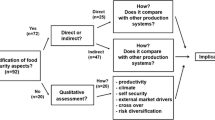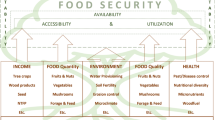Abstract
This paper values the savanna woodland resources of two neighbouring villages in Zimbabwe. Households receive a diverse range of products from a variety of ecologically contrasting sites, and a large number of products are marketed. Whilst the rules and regulations regarding tree-based resources are similar in the two villages, there is a greater degree of enforcement in Jinga, where ecological sustainability is also more promising. Using a derived demand approach, it was found that, in both villages, fuelwood for household cooking, wild fruits and poles are the most important in terms of contribution to total value. The total values obtained for the woodland products investigated are sizeable by comparison to annual cash income. Non-market values (water retention, rainmaking functions, etc.) were ranked highly during participatory rural appraisal techniques. The valuation of a select range of products based on market prices is thus a small component of total economic value.
Resumen
Este artigo avalia os recursos dafloresta de savana de duas aldeias adjacentes no Zimbabwe. Asfamílias recebem uma série de produtos de uma variedade de locais ecologicamente diferentes, e grande número dos produtos são comercializados. Enquanto que as leis e regulamentos em relação aos recursos derivados de árvores são semelhantes nas duas aldeias, existe um major cumprimento da lei em Jinga, onde a sustentabilidade ecológica é tambem mais promissora. Usando um método derivado de avaliação, verifocou-se que, em ambas as aldeias, lenha para cozinhar, frutos silvestres e estacas são mais importantes em termos de contribuição para o valor total. Os valores totals obtidos dos produtos florestais investigados são consideráveis comparados com o rendimento anual. Valores não-comerciãveis (retenção de água, funções de produzir chuva, etc.) foram classificadas no topo da lista durante as técnicas de diagnósticoparticipativo rural. A avaliação de uma série de productos selecionados, baseada em preços de mercado, é assim, uma pequena componente do valor económico total.
Similar content being viewed by others
Literature Cited
Attwell, C. A. M., B. M., Campbell, R. Du Toit, and T. Lynam. 1989. Patterns of fuelwood utilization in Harare, Zimbabwe. Report produced for the Forestry Commission of Zimbabwe and the World Bank, Forestry Commission, Harare. 112 p.
Ajayi, S. 1978. Pattern of bushmeat production, preservation and marketing in West Africa. Nigerian Journal of Forestry 8:48–52.
Anadu, P. A., P. O., Elamah, and J. F. Oates. 1988. The bushmeat trade in southwestern Nigeria: a case study. Human Ecology 16:199–208.
Barbier, E. J., Burgess, T., Swanson, and D. Pearce. 1990. Elephants, economics and ivory. Earthscan Publications, London, UK.
Bojo, J. 1993. Economic valuation of indigenous woodland. Pages 227–234in P. Bradley and K. McNamara, eds., Living with trees: a future for social forestry in Zimbabwe. The World Bank, Washington.
Bradley, P. N., and P. Dewees. 1993. Indigenous woodlands: agricultural production and household economies in the communal areas. Pages 63–138in P. Bradley and K. McNamara, eds., Living with trees: a future for social forestry in Zimbabwe. The World Bank, Washington.
Campbell, B. M. 1987. The use of wild fruits in Zimbabwe. Economic Botany 41:375–385.
—,S. Vermeulen, and T. Lynam. 1991. Value of trees in the small-scale farming sector in Zimbabwe. IDRC, Ottawa.
—,I. Grundy, and F. Matose. 1993. Tree and woodland resources—the technical practices of small-scale farmers. Pages 29–62in P. Bradley and K. McNamara, eds., Living with trees: a future for social forestry in Zimbabwe. The World Bank, Washington.
Chambers, R. 1991. Participatory rural appraisals: past, present and future. Forests, Trees and People 15/16.
— 1992. Rural appraisal: rapid, relaxed and participatory. Institute of Development Studies, Discussion Paper 311, University of Sussex, Brighton.
Chopra, K. 1993. The value of non-timber forest products: an estimation for tropical deciduous forests in India. Economic Botany. 47:251–257.
Conway, G. R. 1989. Diagrams for farmers. Pages 77–85in R. Chambers, A. Pacey, and L. A. Thrupp, eds., Fanner first. Intermediate Technology Publications, London.
Cumming, D. H. M. 1990. Wildlife products and the market place: a view from southern Africa. Project Paper No. 12, WWF Multispecies Animal Production Systems Project, Harare.
Frost, P., E., Medina, J. C., Menaut, O., Solbrig, M., Swift, and B. Walker. 1986. Responses of savannas to stress and disturbances. Biology International Special Issue 10, International Union of Biological Sciences, Paris.
Godoy, R. A., and K. S. Bawa. 1993. The economic value and sustainable harvest of plants and animals from the tropical forest: assumptions, hypotheses, and methods. Economic Botany 47:215–219.
—,R., Lubowski, and A., Markandya. 1993. A method for the economic valuation of non-timber forest products. Economic Botany 47:220–233.
Grandin, B. 1988. Wealth ranking in smallholder communities. Intermediate Technology Publications, London.
Grundy, I., B., Campbell, S., Balebehero, R., Cunliffe, C., Tafangenyasha, R., Fergusson, and D. Parry. 1993. Availability and use of trees in Mutanda resettlement area, Zimbabwe. Forestry Ecology and Management 56:243–266.
Hofstad, O. 1993. Woodland management practices in Zimbabwe. Pages 205–225in G. D. Piearce, and D. J. Gumbo, eds., The ecology and management of indigenous forests in Southern Africa. Forestry Commission, Zimbabwe.
Jackson, J. C, and P. Collier. 1988. Incomes, poverty and food security in the communal lands of Zimbabwe. Occasional Paper No. 11, Department of Rural and Urban Planning, University of Zimbabwe, Harare.
Mascarenhas, J. 1991. Participatory rural appraisal. RRA Notes 13. IIED, London.
McGregor, J. 1991. Woodland resources: ecology, policy and ideology. An historical case study of woodland use in Shurugwi communal area, Zimbabwe. Ph.D. thesis, Loughborough University of Technology, Loughborough.
Muir, K. 1989. The potential role of indigenous resources in the economic development of arid environments in sub-Saharan Africa: the case of wildlife utilization in Zimbabwe. Society and Natural Resources. 2:307–318.
Nhira, C., and L. Fortman. 1993. Local woodland management: realities at the grass roots. Pages 139–156in P. Bradley and K. McNamara, eds., Living with trees: a future for social forestry in Zimbabwe. The World Bank, Washington.
Pearse, P. H. 1990. Introduction to forestry economics. University of British Columbia, Vancouver. 226 p.
Peters, C. M. 1994. Sustainable harvest of non-timber plant resources in tropical moist forest: an ecological primer. Biodiversity Support Programme, World Wildlife Fund, Washington. 45 p.
Peters, C. M., A. H., Gentry, and R. O. Mendelsohn. 1989. Valuation of an Amazonian rainforest. Nature 339:655–656.
Scoones, I. C. 1992. The economic value of livestock in the communal areas of Southern Zimbabwe. Agricultural Systems 39:339–359.
—,M. Melnyk, and J. N. Pretty. 1992. The hidden harvest: wild foods and agricultural systems. International Institute for Environment and Development, London, UK.
Wilson, K. B. 1989. Trees in fields in southern Zimbabwe. Journal of Southern African Studies 15: 369–383.
Author information
Authors and Affiliations
Rights and permissions
About this article
Cite this article
Campbell, B.M., Luckert, M. & Scoones, I. Local-Level Valuation of Savanna Resources: A Case Study from Zimbabwe. Econ Bot 51, 59–77 (1997). https://doi.org/10.1007/BF02910405
Received:
Accepted:
Issue Date:
DOI: https://doi.org/10.1007/BF02910405




